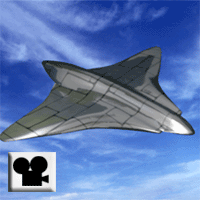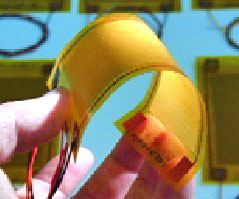Aircraft
"Shape-Memory" Metal Alloys or Other Novel "Smart" Materials
Buck Rogers, Watch Out!
Source: NASA
March 1, 2001
NASA researchers are studying insects and birds, and
using "smart" materials with uncanny properties to develop new and
mindboggling aircraft designs.
Listen to this story:
"Birds are so much more maneuverable than our airplanes
are today. Birds can hover, they can fly backwards and sideways. And
insects -- oh forget it! -- upside down, loop-de-loop, all sorts of
things."
Anna McGowan, program manager for the Morphing Project at
NASAís Langley Research Center
And air-cars are just the beginning.
Self-healing wings that flex and react like living
organisms, versatile bombers that double as agile jet fighters, and
swarms of tiny unmanned aircraft are just a few of the
science-fiction-like possibilities that these next-generation
technologies could make feasible in the decades ahead.
Above right: Tomorrowís airplanes could have self-bending
wings, which might operate without flaps --thus reducing drag and
saving on fuel costs. Click above right image for movie
about some of the next-generation technologies being developed at
LaRC. Image courtesy of Robert C. Byrd National Technology Transfer
Center.
At the core of this impending quantum leap in aerospace
technology are "smart" materials -- substances with uncanny
properties, such as the ability to bend on command, "feel" pressure,
and transform from liquid to solid when placed in a magnetic field.
"This is technology that most people arenít aware even
exists," said Anna McGowan, program manager for the Morphing Project
at LaRC, which develops these new technologies.
Left: Anna McGowan, program manager for the Morphing
Project at NASAís Langley Research Center.
The task of the Morphing Project is to envision what
cutting-edge aerospace design will be like 20 years from now and begin
developing the technologies to make it happen.
For example, a personal air-car needs to be compact, yet
able to fly at both very low and very high speeds.
"We know that to get a íJetsonsí vehicle, youíre
probably going to need a wing that can undergo a radical configuration
change," McGowan said. "The kind of wing you need at very low speed
and the kind of wing you need at high speeds are completely
different."
Some airplanes today can already reorient their wings,
such as the Navyís F-14 Tomcat and the B-1 supersonic bomber. These
planes use rigid wings mounted to large, heavy pivots in the planeís
body.
In contrast, Morphing Project scientists envision a wing
that will unfurl on command using "shape-memory" metal alloys or other
novel "smart" materials. The material of the wing itself would bend to
create the new shape.
Shape-memory alloys have the unusual property of
snapping back to their original shape with great force when a certain
amount of heat is applied. Any shape can be "trained" into the alloy
as its original shape.
An artistís conception illustrating some of the features
that may define cutting-edge aircraft 20 years from now. In addition
to self-bending wings, this rendition shows piezoelectric sensors that
provide real-time strain data, enabling the plane to "feel" the motion
of its wings as birds do. Synthetic jets allow the plane to minutely
alter the flow of air over the wings, providing subtle aerodynamic
control as feathers do.
Among the exotic "smart" materials being developed by
the Morphing Project, shape-memory alloys are relatively ordinary.
Imagine seeing a bullet shot through a sheet of
material, only to have the material instantly "heal" behind the
bullet! Remember, this is not science fiction. Self-healing materials
actually exist, and LaRC scientists are working to unravel their
secrets.
"What we did at NASA-Langley was basically dissect that
material to answer the question, íhow does it do that?í" McGowan said.
"By doing so, we can actually get down to computational modeling of
these materials at the molecular level."
"Once we understand the materialís behavior at that
level, then we can create designer ísmartí materials," she added.
LaRC is also developing customized variations of
piezoelectric materials. These substances link electric voltage to
motion. If you contort a piezoelectric material a voltage is
generated. Conversely, if you apply a voltage, the material will
contort.
Scientists can use such properties to design
piezoelectric materials that function as strain sensors or as
"actuators" --
Left: This thin, flexible film contains a piezoelectric
material that responds to the bend by producing a voltage thatís
detected by the electrodes seen at the bottom left of the image.
Combined with micro-electronics, these materials could
lead to a radical advance in airplane design.
"When we look 20 years into the future, we see airplanes
that have distributed self-assessment and repair in real time,"
McGowan said.
"To make this technology possible, you would need to
distribute these actuators and sensors throughout the wings. Thatís
similar to how the human body operates. We have muscles and nerves all
over our bodies -- so we are aware of whatís happening to our bodies
and we can respond to it in a number of ways."
The resemblance to biology doesnít end there. One avenue
of Morphing Project research is to examine how nature does the things
that it does well. Scientists hope they can learn lessons from this
tutelage to improve their own designs.
"Nature does some things that we canít even get close to
doing. Birds are so much more maneuverable than our airplanes are
today. Birds can hover, they can fly backwards and sideways. And
insects -- oh forget it! -- upside down, loop-de-loop, all sorts of
things. We canít even get close to that [yet]," McGowan said.
Called "biomimetics," this practice of learning from
nature has led to the development of -- among other things -- a
facsimile of bone.
Bone is very light because of its porous interior, but
itís also very strong. LaRC scientists can make structures similar to
bone by injecting polymer microspheres into composite shells of the
desired shape, then heating the spheres to make
Right: LaRC scientists are studying nature to understand
how birds and insects achieve their high degree of efficiency and
maneuverability.
"If you can have the strength and lightweightness of
these bone-like structures that Iím talking about, then add in
nerve-like sensors and these flexible actuators, what youíre going to
end up with is an extremely light-weight, very strong, self-sensing,
self-actuating structure."
Compare that vision to the rigid, numb, heavy structures
airplanes are made of today, and youíll get a sense of the dramatic
difference "smart" materials could make in aerospace design.
As with all basic science, the applications of these
"smart" materials will extend to technologies outside of the aerospace
industry.
"We are working very closely with two different
commercialization groups funded by NASA," McGowan said, "and the
outlook for this technology is on the order of millions of
applications."
http://science.nasa.gov/headlines/y2001/ast01mar_1.htm?list109259
 -- The "personal aircraft" that replaces the beloved
automobile in peopleís garages may still lie in the realm of science
fiction or Saturday-morning cartoons, but researchers at NASAís
Langley Research Center (LaRC) are developing exotic technologies that
could bring a personal "air-car" closer to reality.
-- The "personal aircraft" that replaces the beloved
automobile in peopleís garages may still lie in the realm of science
fiction or Saturday-morning cartoons, but researchers at NASAís
Langley Research Center (LaRC) are developing exotic technologies that
could bring a personal "air-car" closer to reality.
 devices that create small motions in machines, like the
moving of wing flaps.
devices that create small motions in machines, like the
moving of wing flaps.
 them fuse together
like tiny soap bubbles.
them fuse together
like tiny soap bubbles.